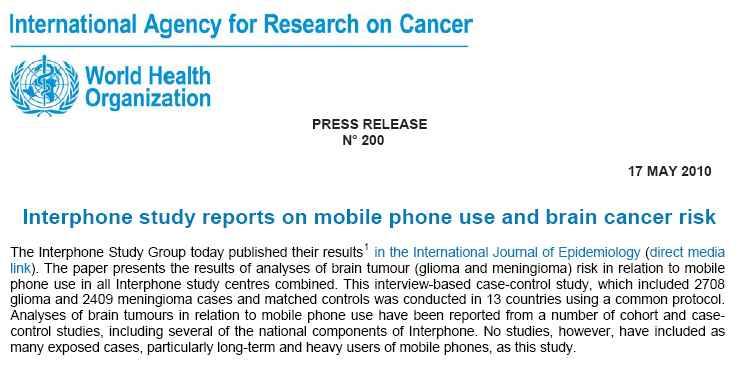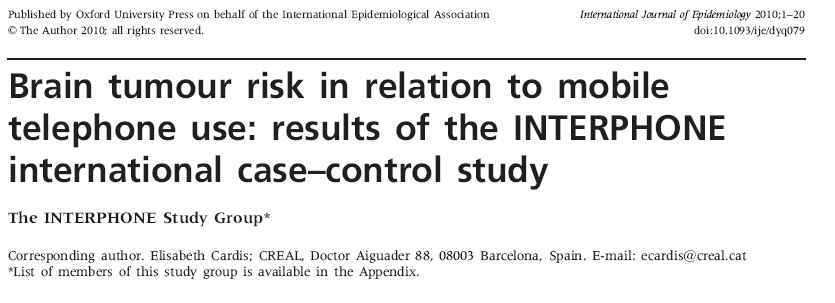
..................................................................................................................................................................................................................

..................................................................................................................................................................................................................


The long awaited Interphone Study has just been released. The Interphone Study is an international 13 country case control study that was coordinated by the IARC/WHO. In this case control study patients who had been diagnosed with brain cancer were interviewed concerning their past cell phone use. Studies of this type are subject to a number of potential sources of error such as recall bias. However, the conclusion of the study is important: "Overall, no increase in risk of glioma or meningioma was observed with use of mobile phones. There were suggestions of an increased risk of glioma at the highest exposure levels, but biases and error prevent a causal interpretation. The possible effects of long-term heavy use of mobile phones require further investigation."
The authors note that the Interphone study is consistent with other studies done to date in that no evidence was found that cell phones cause brain cancer. However, inconsistencies in the data prevent the authors from reaching a definitive conclusion. The authors spend a good portion of their paper analyzing errors and inconsistencies in their data. On this page we have provided our analysis as well as links to the official press release on the Interphone Study, an analysis from the prestigious science journal Nature, and the full text of the study.
Also see our page on the varied press coverage of the Interphone Study
The authors note that the Interphone study is consistent with other studies done to date in that no evidence was found that cell phones cause brain cancer. However, inconsistencies in the data prevent the authors from reaching a definitive conclusion. The authors spend a good portion of their paper analyzing errors and inconsistencies in their data. On this page we have provided our analysis as well as links to the official press release on the Interphone Study, an analysis from the prestigious science journal Nature, and the full text of the study.
Also see our page on the varied press coverage of the Interphone Study
The Interphone Study: Our Analysis
We highly recommend the article entitled "No link found between mobile phones and cancer" from the prestigious science journal Nature. It provides a balanced assessment of the Interphone study. The Interphone Study is consistent with other studies done to date in that not evidence was found that cell phones cause brain cancer. However, inconsistencies in the data prevent the authors from reaching a definitive conclusion. Here we add backup to the Nature article by highlighting a number of inconsistencies from the study which led the Interphone authors to state: "but biases and error prevent a causal interpretation". In the following we have made our comments in plain text, and supporting quotes taken directly from the Interphone study are shown in italics. It is important to note that the Interphone authors have followed correct scientific protocol by identifying inconsistencies in their data and potential sources of error.
The study found "decreased risk for ever regular use of a cell phone" for most users. This is not plausible and the Interphone authors state: "The reduced OR (odds ratio) for regular users compared with never regular users seems unlikely to reflect a genuine protective effect and makes our results difficult to interpret.....We have no certain explanation for the overall reduced risk of brain cancer among mobile phone users in this study, although selection bias is almost certainly a contributor".
The class of users with the longest call times seemed to have an elevated risk for glioma (glioma in the highest decile of cumulative call time). Since this is the point of greatest concern in the study, we will review specific points in the study which the authors have identified as source of error.
The Interphone authors listed the following sources of error for apparent elevated risk for this class of cases:
"In contrast, increased risks of malignant brain tumours at higher levels of accumulated use of analogue and digital mobile phones and cordless desktop phones were reported from a sequence of three case-control studies from the same authors with cases in the last diagnosed as late as 2003. However, the methods of these studies have been questioned (Ahlbom A. et al. Epidemiologic evidence on mobile phones and tumor risk: a review. Epidemiology 2009;20:639-52). The Nature article referenced below quoted Anthony Swerdlow, an epidemiologist at the Institute of Cancer Research in London who was involved in the UK arm of the study, as saying that Hardell's studies are an "outlier in the literature"
Taken together all these potential sources of error and inconsistencies in the data explain the conclusion of the Interphone study. "Overall, no increase in risk of glioma or meningioma was observed with use of mobile phones. There were suggestions of an increased risk of glioma at the highest exposure levels, but biases and error prevent a causal interpretation. The possible effects of long-term heavy use of mobile phones require further investigation."
We highly recommend the article entitled "No link found between mobile phones and cancer" from the prestigious science journal Nature. It provides a balanced assessment of the Interphone study. The Interphone Study is consistent with other studies done to date in that not evidence was found that cell phones cause brain cancer. However, inconsistencies in the data prevent the authors from reaching a definitive conclusion. Here we add backup to the Nature article by highlighting a number of inconsistencies from the study which led the Interphone authors to state: "but biases and error prevent a causal interpretation". In the following we have made our comments in plain text, and supporting quotes taken directly from the Interphone study are shown in italics. It is important to note that the Interphone authors have followed correct scientific protocol by identifying inconsistencies in their data and potential sources of error.
The study found "decreased risk for ever regular use of a cell phone" for most users. This is not plausible and the Interphone authors state: "The reduced OR (odds ratio) for regular users compared with never regular users seems unlikely to reflect a genuine protective effect and makes our results difficult to interpret.....We have no certain explanation for the overall reduced risk of brain cancer among mobile phone users in this study, although selection bias is almost certainly a contributor".
The class of users with the longest call times seemed to have an elevated risk for glioma (glioma in the highest decile of cumulative call time). Since this is the point of greatest concern in the study, we will review specific points in the study which the authors have identified as source of error.
The Interphone authors listed the following sources of error for apparent elevated risk for this class of cases:
- In a higher percentage of cases, another person answered the questionnaire because the subject was too ill or deceased: "When compared with controls, glioma cases had a higher proportion of proxy respondents,...
- In a higher percentage of cases missing responses were estimated: "a higher number of imputations for missing values,..."
- In a higher percentage of cases subjects were judged to be unreliable: "and a higher proportion of subjects judged by their interviewer to be non-responsive or having poor memory"
- The authors identified "recall bias" as potential source of error: "First, a brain tumour, particularly in the frontal or temporal lobes, may adversely affect cognition and memory (memory accuracy may have been affected by the brain tumor). Secondly, cases may be more motivated to recall and report a publicized potential risk factor for their disease" (recall bias may have been significant).
- The authors noted that some subjects greatly exaggerated their cell phone usage: "Some subjects reported very high daily average call times and this was more common among cases than controls. Thirty-eight cases and 22 controls reported >5 h use/day and 10 cases and no controls reported >12 h/day. There is reasonable doubt about the credibility of such reports."
- There was a lack of coherence and consistency in the data. The risk for for cumulative call time the risk was 1.4, whereas for the largest number of calls the risk was less than one: "For the cumulative number of calls, the OR's (odds ratios), while highest in the highest deciles, were consistently below one".
- Risk did not increase with length of time since first use, which is not plausible if cell phone use caused brain cancer: "The apparently increased risk of glioma for cumulative call time was restricted to the top decile, >1640 h. There was no upward trend across the first nine deciles of cumulative call time. In contrast with the excess risk seen on the scale of cumulative call time, risk did not appear to be increased by length of time since first exposure or by duration of exposure. The pattern of point estimates of OR's in the high call time categories in three strata of time since exposure started-3.8 in the most recent and 1.3 in the more distant ones (Table 3)-is not what one would expect if there were a causal association.....the highest OR for cumulative call time was seen among subjects who had recently started regular use".
- Results are consistent with other studies such as the Danish cohort study that found no increased risk of brain tumors: "Our results are consistent with most of the research published to date. A large Danish cohort study of mobile telephone subscribers,8,9 with an average follow-up time of 8.5 years, found no increased risk of brain tumours in subscribers of >10 years."
- In vitro and in vivo studies have not found evidence for cancer: "Much biological research has been done in recent years on possible biological effects of RF fields. This work covers in vitro and in vivo exposure, alone and in combination with other physical or chemical agents, and has found no evidence that RF fields are carcinogenic in laboratory rodents or cause DNA damage in cells in culture."
"In contrast, increased risks of malignant brain tumours at higher levels of accumulated use of analogue and digital mobile phones and cordless desktop phones were reported from a sequence of three case-control studies from the same authors with cases in the last diagnosed as late as 2003. However, the methods of these studies have been questioned (Ahlbom A. et al. Epidemiologic evidence on mobile phones and tumor risk: a review. Epidemiology 2009;20:639-52). The Nature article referenced below quoted Anthony Swerdlow, an epidemiologist at the Institute of Cancer Research in London who was involved in the UK arm of the study, as saying that Hardell's studies are an "outlier in the literature"
Taken together all these potential sources of error and inconsistencies in the data explain the conclusion of the Interphone study. "Overall, no increase in risk of glioma or meningioma was observed with use of mobile phones. There were suggestions of an increased risk of glioma at the highest exposure levels, but biases and error prevent a causal interpretation. The possible effects of long-term heavy use of mobile phones require further investigation."

Except where noted all images on this web site are taken from the Wikipedia commons
All trademarks are the property of their respective owners Copyright 2009 EMF & Health
All trademarks are the property of their respective owners Copyright 2009 EMF & Health


